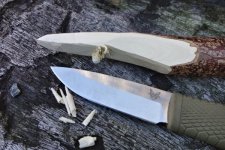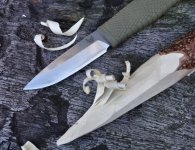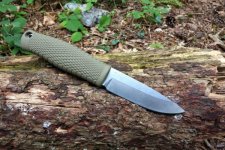Funny, I was thinking about it again today. There are a number of things I have that I want to review, but the Bechmade may be the longest held. This isn't the review I was going to post, but I hope it helps with your decision making.
View attachment 63099
Its kind of love/hate for me. I WANT to love it, but it has some flaws which make it hard. I have not used a knife with a CPM3V blade and have wanted to for a long while. That is partly why I bought the Benchmade. The other part was that the handle looked like some real thought had gone into the ergonomics.
Attention: I have been told I am very glass-half-empty when reviewing things. Even things I LIKE! I am an engineer and by training and inclination I want to see problems solved. It is very hard for me, when reviewing, not to do it the way I would do during an engineering project, where the weight is on highlighting problems and places for improvement rather than describing all the things that are right.
On to my critique...
View attachment 63098
View attachment 63102
View attachment 63101
All looking good, but...
The sheath is awful. I would not recommend anyone carry the knife unless they can get a replacement sheath made for it.

I am not talking about the overall design, which looks nice and hangs well, nor am I fussing about the leather being 2mm, which is thinner than I like but still okay. Or even that the ferro-rod loop is too small for a standard ferro rod to fit, which is a pity. No, the problem is that the sheath does not hold the knife when inverted. At all. So if you take a tumble there is an excellent chance that the knife will go flying. Less dramatic, if you wear while in a boat or vehicle where the dangler lets the sheath articulate, or if you drop the knife in a day pack, there is a good chance the knife will fall free. I had it fall out once in a bag and once as I removed it from a bag and think I avoided cuts more by luck than anything else.
I believe the reason is the plastic liner that runs the whole length of the sheath and is clearly there to bolster the safety of the light weight leather. The liner is smooth and gives minimal friction with the handle, the handle has no shaping that the sheath can get hold of. Traditional puukko sheaths retain knives with similar shape by moulding around the handle and friction. Unlike the Spyderco knives where the liner was short and can be removed, I don't see how this could be done on the Benchmade, or even that it would be worth doing. I don't think the sheath could be tightened up on the knife and wouldn't want to bet that the knife couldn't be put in twisted and cut an unlined sheath. I made myself a Kydex sheath so that I could use and test.
The other thing that I really don't like is the handle texture. Gripping it hard left a painful imprint on my palm. I didn't get blisters when using it for spoon carving, and I believe Dean said he just started to get a hot spot near the end of his session (I had re-ground the edge between his try and mine). It means that when I pick it up, it does not feel "nice" to me to hold. No doubt it is a good shape for medium hands (cannot speak for large, its not a fat handle so I think small to medium would suit best), and its not going anywhere in wet conditions, but I think adequate grip could be achieved, with that shape, with a LOT less texture.
View attachment 63103
View attachment 63104
The handle looks to me like someone who knows bushcraft designed the shape, then one of the tactical/hunting designers was given the job of texturing, and alarmed at the lack of guard, went a bit overboard to ensure a "safe" grip.
Reminds me of something Ed Fowler wrote in Blade Magazine years ago, describing some of his early work. He made a knife with a chequered handle, thinking it would be great for grip when skinning big game. The knife chewed his hand all to bits because the texture grabbed at him and resisted all the little adjustments in grip that go on when using a knife to skin. He went on to describe how he identified a number of holds, made some knives, took them to a slaughter house and was amazed to see how the pros used an infinite variety of holds, far in excess of the ones he had identified.
It could be my imagination, but on heavy cuts in a hammer grip, I keep thinking I can feel the tang pushing up through the handle material. Not that the handle is really soft, it could be just that I am used to a fatter handle at that point. I had the more of that feeling with the Kraton handle on my Cold Steel SRK, but not at all on a Fallkniven F1, for comparison.
The edge angle from the factory is standard factory knife obtuse. Dean managed to carve a spoon (Dean is pro-level spook carver!), but when I tried working with it I quickly decided it was not fun and needed re-grinding. Strangely, some American forumites are full of praise for the blade, saying how it "comes ready for the user to customise to their own needs." Hmmmm...

....yeah.....right. I did the regrind by hand, just to see how hard it was in CPM 3V. Its not as easy as O-1, but it isn't awful. I took it to a sort of convex-ish profile. The blade is what the Americans would call a sabre grind, and with the abrasion resistance of 3V you would not enjoy maintaining the whole primary bevel as the cutting bevel, so some sort of secondary is useful.
These are the shavings from a piece of seasoned hazel with the edge sharpened at factory angles.
View attachment 63105
These are shavings with the edge re-ground to a lower angle.
View attachment 63106
Quite a lot of US forumites have pointed out that Benchmade have tempered the 3V to a lower than optimal hardness for the inherent toughness of the alloy; that they could have gone harder and the blade would still have been tougher than O-1 but with better edge retention. That does look like what has been done, based on numbers. This is going to be one VERY tough blade. On the plus side, it makes the re-grind and sharpening easier. I found the edge I used plenty robust and long lasting. I think it held up better at the low angle than the O-1 and stainless blades I am used to. Good bite, it held a polished edge well. I looked around at other options for getting a 3V knife in a useful shape, and didn't see any that compared well enough on design and price point to buy instead of the Benchmade.
The blade shape is good, a nice useful drop point. I used it for feather sticks, spoons, skinning some small game, gutting trout, and boning a couple of leg-roasts. Last year I used it while doing some bushcraft teaching and it did some baton cutting, splitting, shaving and carving of trap triggers. The only thing it hasn't been great for is cutting veg...which isn't really a revelation given its geometry.
Note, the blade looks like it was tumble finished, so the from-factory spine edges are slightly radiused. If you want to use the spine to scrape a ferro rod, you need to do some light grinding (if anyone thinks I mean angle grinder or bench grinder...I don't).
Lastly thing, price. In the US it is fantastic value, just $128 from BladeHQ At that I would say it is a no-brainer to buy one, get a new sheath made, re-grind it and overlook waffle-palms. In the UK, prices appear to be quite varied and make little sense. When I bought mine from Heinnie, it cost £159.95. Later Heinnie started selling the 202 Leuku for £138.95, a larger knife of the same steel with the same handle, while the 200 Puukko was still £20 more. Moonraker is still selling at £159.95, but Heinnie have dropped it to £126.10, (neither 200 or 202 is showing stock now

). Other sellers are dotting around between £139 and £149. Knivesandtools sells the Puukko for £143, vs £138 for the Leuku.
If I had bought at Heinnie's current price I would have felt a lot better, the $XXX=£XXX conversion is one I am long familiar with and puts the Benchmade back down into the price range of the knives I see as its serious competition. That competition is Lion Steel, who have two dedicated bushcraft models plus others that are good outdoors knives, with excellent steel, ergonomics, finish, CNC contoured handles in G10, wood and Micarta, and really nice Italian leather sheaths in the £123 to £150 range.
Conclusion:
So, sheath can be replace, edge can be re-ground, handle texture can be lived with (and does have some benefits), but it REALLY bothers me. Design is handy, not great comfort for heavy feather stick cuts, but deft and nimble for spoons and meat prep. I like the steel, even if it isn't optimal hardness. I find the price hard to swallow for something with a rubber handle that needs the sheath replaced.
Its still love/hate.

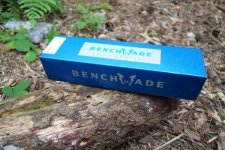
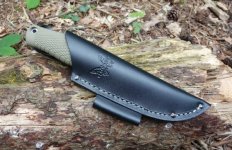
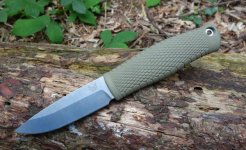
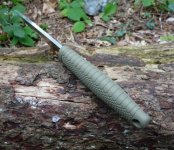
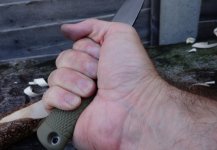
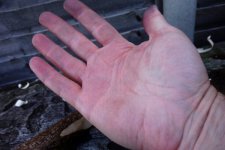
 ....yeah.....right. I did the regrind by hand, just to see how hard it was in CPM 3V. Its not as easy as O-1, but it isn't awful. I took it to a sort of convex-ish profile. The blade is what the Americans would call a sabre grind, and with the abrasion resistance of 3V you would not enjoy maintaining the whole primary bevel as the cutting bevel, so some sort of secondary is useful.
....yeah.....right. I did the regrind by hand, just to see how hard it was in CPM 3V. Its not as easy as O-1, but it isn't awful. I took it to a sort of convex-ish profile. The blade is what the Americans would call a sabre grind, and with the abrasion resistance of 3V you would not enjoy maintaining the whole primary bevel as the cutting bevel, so some sort of secondary is useful.